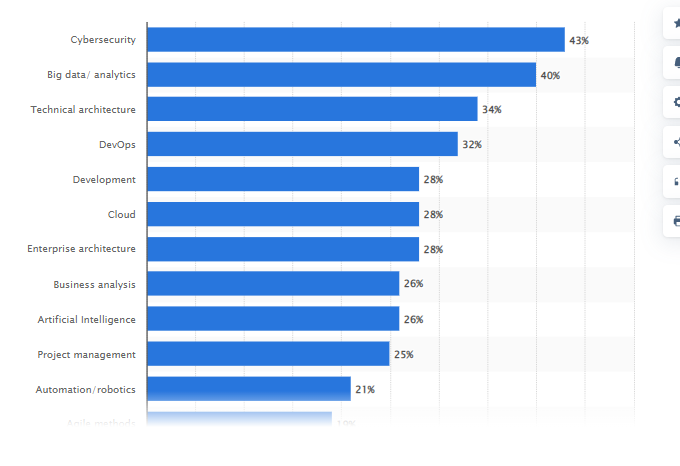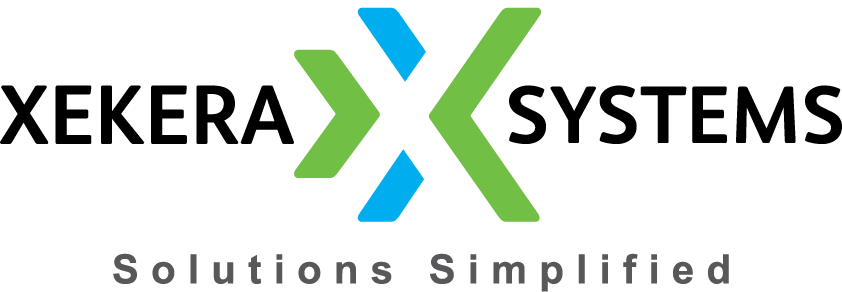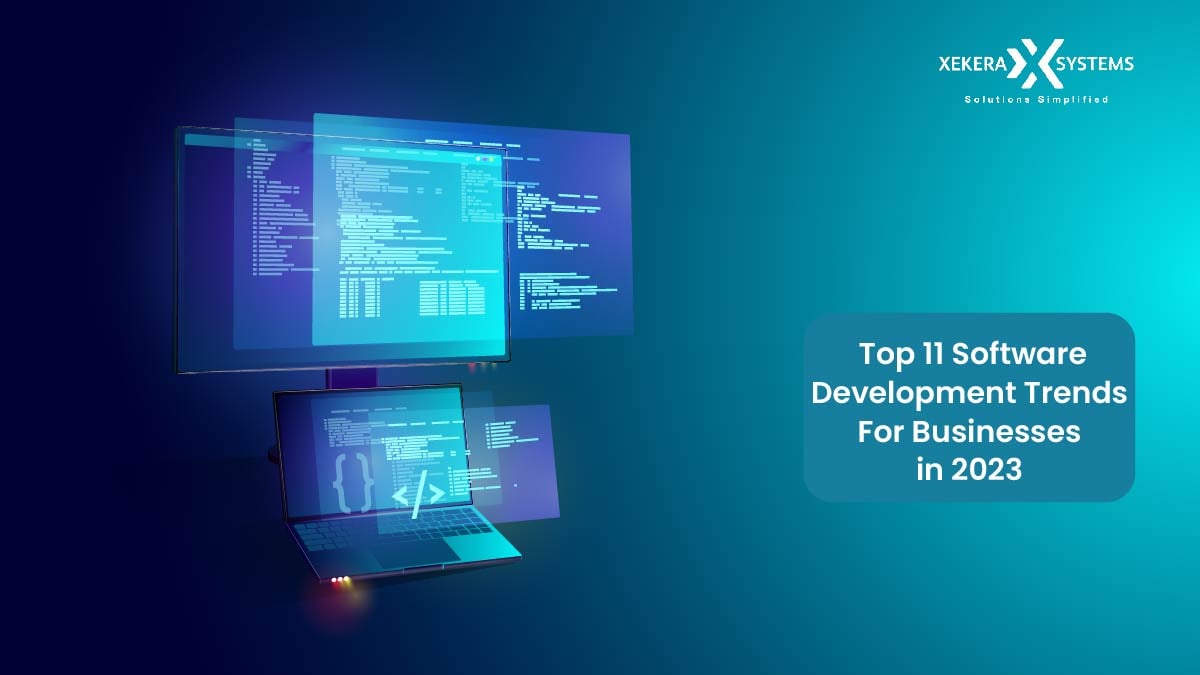The software development patterns in 2022 have become even more stable in the post-pandemic circumstances. In fact, it is anticipated that between 2022 and 2030, the global market for software development will grow at a CAGR of 11.7%.
We’ve produced a list of the top 11 software development trends (2023–2024) that could boost the revenue of your company after observing that our clients are paying more attention to this area.
Let’s begin straight away.

Software development trends worth noting
The market for business software and services, which was estimated to be worth USD 429.59 billion in 2021, is anticipated to grow at a CAGR of 11.7% from 2022 to 2030.
The expansion of the market is being driven by the increased automation of corporate processes and the increasing amount of enterprise data in sectors like retail, manufacturing, and healthcare.
Additionally, the market is expanding due to the quick adoption of business software and services across IT infrastructure in order to enhance decision-making, save inventory costs, and boost profitability.
Businesses should promptly adapt the newest trends in software development in light of the booming software market in order to stay one step ahead of their rivals.
11 Key software development trends (2023-2024)
1. Businesses Adopt Low-Code And No-Code Development
Software development frequently overcomes obstacles and setbacks.
All software projects fail in about 20% of cases, and another 52% are “difficult.”
Not to mention that the procedure is really pricey.
As a result of such issues, some businesses in the software development sector have begun to streamline their software development processes.
As straightforward as its name suggests, the software created in this fashion does not require sophisticated IT expertise or coding skills.
As a result, it enables low-code and no-code software development to result in a simpler and more rapid development process.
Platforms without programming are more approachable. Now users can drag and drop blocks or pre-made code in a visual interface rather than using conventional programming.
The growth of “no-code” searches over a five-year period was 8.100%.
Low-code platforms, on the other hand, demand greater technical expertise but nonetheless offer efficiencies that speed up software development.
According to a Forrester survey, companies employing low- or no-code platforms processed data more efficiently than those using conventional platforms.
Additionally, it claimed that the no-code strategy offers non-technical specialists a smooth user experience.
More specifically, specialists in the field they specialise in can create software without any coding knowledge. This makes it simpler than ever before for small businesses or SMEs to sell their products.
An illustration of a visual development tool is Quickbase (a no-code platform).
Even those with little to no coding knowledge may easily automate complex operations with the click of a mouse thanks to a stunning drag-and-drop builder.
Other well-known low-code platforms to think about are Mendix and Appian.
2. Work Remotely Drives An Increase In Cloud Computing
Most firms increased their ability to operate remotely during the pandemic, and their IT requirements underwent a significant change.
As the epidemic fades, hybrid working emerges as a new working style. Because it gives them more flexibility, some people still prefer to work remotely, while others prefer to go into the office.
Solutions like cloud services are needed in the present workplace since they enable workers to be productive even while they are at home.
The market for cloud computing will be $623.3 billion by the end of 2022. That amount will surpass $800 billion by the year 2025.
The amount that end users spent on public cloud services increased by 17% in a year, from 2021 to 2022. In 2023, this figure is expected to increase even more quickly.
DaaS spending is expected to reach $2.6 in 2022 as a result of hybrid work’s push for companies to replace their traditional client computing solutions (desktops, in-office tools, etc.) with DaaS.
The demand for cloud-native software engineers has never been higher due to the enormous expansion of this sector.
The amount of searches for “cloud engineering” increased by 900% over a 5-year period.
3. Malicious Software Development Ramps Up
Cybersecurity will probably continue to be a big issue in the coming years.
Ransomware in particular is still one of the biggest risks to organisations. As a result, businesses will look for equipment to assist safeguard their assets.
In just one year, from 2019 to 2020, the rate of ransomware infections soared by 435%.
Paid ransoms have increased as well. From Q2 to Q4 2020, the average monthly payment rose 31% to $233k in November.
Ransomware attacks have terrible effects. Double extortion is one of the techniques used most frequently by ransomware.
In which the victim is held hostage and threatened with the release of sensitive information if the attackers’ ransom demands are not met.
Businesses that have completely equipped themselves with security automation can save up to $3.58 million in the case of a data breach, according to a survey from IBM Security.
Cyber insurance will be purchased by many firms that see the value of cyber security.
This points to a growing tendency for the creation of security software, one that organisations should anticipate.
4. AI Adoption Accelerates
The IDC predicted that the worldwide AI industry will grow by more than 16% in 2021, reaching $327.5 billion, and then approach $500 billion by 2024.
Surprisingly, the adoption rate has risen even faster since Covid-19 and is expected to continue to rise.
A growing number of companies are implementing AI because it lowers costs by boosting productivity and minimising errors.
According to experts, AI may bring $1 trillion in value annually to the banking sector alone.
Additionally, it enables banks to offer the kind of hyper-personalization that today’s consumers demand.
The industry that will experience the most significant effects from AI software in the upcoming year is the healthcare sector.
According to a poll conducted in March 2021, nearly 90% of hospitals have AI initiatives in place.
Robotic Process Automation (RPA) is one way that AI software is having an impact in the corporate world (RPA).
Automation of routine processes allows experienced workers to concentrate on projects with higher potential value.
RPA is being used by more than half of firms, and 20% of them aim to employ it within the next two years, according to a poll.
In 2022, applications for RPA could include lead nurturing, data entry, mass emails, and financial planning.
5. Rust Gains Momentum
Rust is the programming language experiencing a breakout in the first few months of 2022.
This programming language has now surpassed all others in popularity.
To create high-performing programmes, use the system programming language rust.
It is renowned for its efficiency and security, particularly with regard to memory management and safe currency.
In a recent poll, users ranked Rust as the second most fascinating programming language to learn.
Rust is also used in production by some well-known companies, like Facebook, Dropbox, and Amazon.
6. Continued Expansion Of The IoT
In 2022 and beyond, the Internet of Things (IoT) is expected to keep growing.
In 2025, there will be 65 billion IoT devices, according to statistics. That is a 6x increase from 2018.
Particularly smart speakers are anticipated to gain popularity further. The market may be valued $35.5 billion in 2025, according to estimates.
Forrester predicts that in 2021 and beyond, sales of wearables and sensors that let patients check their own health at home will soar.
Patients’ data can be used by doctors to improve care and help them be more proactive in their medical interventions.
The IoT has applications well beyond its domestic use.
A cheap Internet of Things chip that resembles a postal label was recently produced by Bayer.
This chip can be used to track products during the distribution process, whether they are seeds or chemical substances.
IoT applications are not limited to the industrial sector; they also exist in the office.
7. Progressive Web Apps (PWAs) Aim To Provide A Better User Experience
Smartphone users often favour smooth and safe app experiences, but they don’t frequently download apps since they use up too much storage space on their phones.
In fact, Google made the observation that up to 50% of smartphone users prefer a brand’s mobile website to an app.
As a result, a lot of businesses that are aware of this insight are using progressive web apps (PWAs) as a solution.
These apps offer the ease of an app with the functionality of a typical website.
PWAs are significantly lighter than conventional apps. For instance, the PWA from Twitter only uses 3% of the storage of the Android app compared to the native version.
PWAs utilise the same HTML, CSS, and JavaScript as websites do, but one aspect that sets them apart is the removal of the browser interface and borders.
PWA users do not need to download the entire app; they can simply store it to their home screen.
PWAs load rapidly and function similarly to native apps in terms of push notifications. As a result of data caching, they are also accessible offline.
Platform-agnostic PWAs are becoming more and more popular among developers since they eliminate the need for distinct mobile, tablet, and desktop apps.
PWAs help brands save money in a number of areas, including development simplicity. These apps are also less expensive to maintain and easier to design.
8. Microservices Architecture Simplifies Deployment And Scaling
The market for cloud microservices is increasing quickly, according to Technavio. By 2026, they forecast, the CAGR will be greater than 25%, raising the market’s value by $1.59 billion.
Using microservices architecture is a cutting-edge method of developing software.
Monolithic architecture, the conventional method, entails connecting all application activities and executing them as a single service.
A change to one process involves a change to the entire application because the code is grouped together. This approach is neither adaptable nor expandable.
The ability to create apps that are independent of other services is provided by a microservices architecture, on the other hand.
The management and modification of these modules won’t have an impact on the other elements.
The necessity for developers to spend time creating and maintaining applications is gone thanks to the new structure. They can also use their applications in other projects thanks to this.
According to a poll done by IBM in 2021, 88% of the company’s current microservices users concur that employing a microservices architecture has several advantages for their development teams.
Additionally, 87% said it was worthwhile to pay the price for using this strategy.
9. Use Of Blockchain In Software Development Expands
Although blockchain technology has primarily been discussed in relation to cryptocurrencies, it also has potential uses in the software development sector.
More than 80% of businesses concur that blockchain technology and other digital assets will open up new revenue opportunities for them.
Meanwhile, more than 73% of respondents claimed that they would lose competitive advantages if they didn’t follow this new trend.
Systems using blockchain-oriented software (BOS) are incredibly reliable and secure. The security of its data is guaranteed by the decentralised replication and storage of such data.
Additionally, there are numerous levels of security that aid in preventing unwanted access. Users cannot edit or remove the data; they can only read and record it.
Decentralized applications are a specific category of app that uses blockchain technology as its foundation (dApp).
No centralised location for storing code or organisations to administer it exist, as implied by the term. Thus, there is no need for an intermediary.
In other words, users are no longer dependent on third parties like Grab or Airbnb. They are now able to access platforms and services directly.
10. Companies Turn To Outsourcing In The Face Of IT Skills Shortage

Despite the rapid development of new technology, businesses are finding it difficult to implement them due to a lack of competent employees in the IT sector.
According to a Gartner research for 2021, 64% of executives feel a shortage of skills is the biggest adoption obstacle for their company. In contrast, in 2020, it will only be 4%.
Cybersecurity and big data/analytics are the top two tech fields where there is a shortage of personnel, according to Statista.
73% of technology leaders think it’s either very tough or somewhat challenging to find IT talent and fill available roles, according to a 2022 survey.
There may be 85 million vacant positions by 2030, costing the world economy $8.5 trillion.
Many businesses are using unconventional hiring practises to overcome the talent shortage, such as training candidates in boot camps.
In the past, roles for software developers required a particular level of academic preparation.
However, currently, approximately 80% of HR professionals are accepting applications from people who have attended boot camps for training.
Another tactic used by IT departments to scale and maintain agility without the hassle of hiring additional staff and the strain of paying them exorbitant wages is outsourcing.
From $522 billion in 2021, the market for IT outsourcing is anticipated to increase to $689 billion by 2027.
11. DevSecOps Approach Integrates Security Into The Development Process
DevSecOps, a novel methodology that combines security, operations, and development, enables businesses to create software that is secure throughout its entire lifecycle.
DevSecOps integration is essential for establishing security without hindering development or delaying releases.
Developers can address security problems in code in real-time rather than stressing about security at the end of the development process.
As a result, the most secure software is released as soon as possible.
Conclusion
The top 11 significant trends in software development for 2023–2024 have been concluded.
You can see the opportunities that technologies can give your organisation throughout the essay.
Finding out which one can be your secret blackjack can help your company stand out from the competitors.
About Xekera Systems:
Our team of highly qualified developers at Xekera Systems Technology concentrates on creating projects that are specific to your company’s requirements. Our clientele adore the fact that our software development services can help them.



